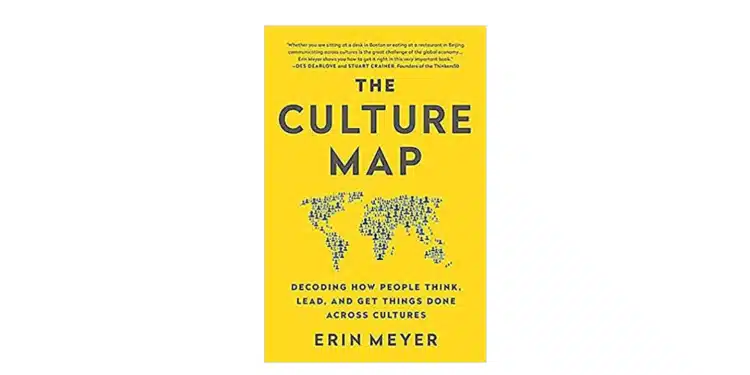The culture map by Erin Meyer
Communication across cultures is the great challenge of the global economy, now more than ever, where you work is meaningless, and the question is: whom can you work with?
Erin Meyer is a professor at INSEAD, one of the world’s leading international business schools and is an expert in navigating the complexities of cultural differences in a multicultural environment.
The book doesn’t fall into the classic cultural bias/categorisation of people based on their origins. It is not meant to be judgemental of people and to classify based on stereotyped silos. What the author is achieving here is helping us to be open to recognise and understand people around us. Observe and become aware of cultural behaviours and understand how to adapt to get the best from our business and human relations.
The culture map will become an inseparable friend that will prepare you in leading global teams, adapt to a new country, and understand cultural differences using them for your success. The book is rich with stories and anecdotes about cultural misunderstandings and examples of miscommunication and is a scientifically proven source of data and information to overcome them.
The author starts the book with a great example of the invisible boundaries that divide the world. Although we are globally connected via mail or phone, it’s challenging to capture the cultural differences as we all seem to have flattened our personalities. So when you start to talk via video or meet the person you’ve been doing business remotely for a while, you may not be aware of the cultural differences that might divide you and be open to accepting them is not enough. Recognise cultural context adapting your behaviour based on said understanding will make you a successful world leader. One of the numerous valuable tools to quickly understand these differences is the culture map that shows where countries sit against actions like
- Communicating: low-context Vs high-contest
- Evaluation: direct negative feedback Vs indirect negative feedback
- Persuading: principles-first Vs application-first
- Leading: egalitarian Vs hierarchical
- Deciding: consensual or top-down
- Trusting: task-based or relationship-based
- Disagreeing: confrontational Vs avoids confrontation
- Scheduling: linear-time Vs flexible-time
It’s imperative to complete an analysis of where your Country is placed on the map to compare others correctly. I appreciate a more hierarchical work structure than my colleagues in the Netherlands, but I am considered very egalitarian by the Japanese ones. The perspective of where you sit on the map depends on who’s looking at you and vice versa.
I am Italian, and I live and work in London; this information should inform you about my work behaviour versus in my free time. Let’s not forget that we pick up behaviours from the environment we live and work in, and everything becomes part of our culture. Imagine now this situation multiplied with the number of people leaving abroad and travelling the world for work and leisure. The result is an incredible layered culture that is very important to recognise. Awareness is the keyword.
Examples of how your leadership can be affected are very well described in the book. Like the case of the manager that used to cycle to work in Amsterdam but once landed a significant role in China, he had to learn fast that his “equality” journey to the office was embarrassing his team. The employees felt they could look less important to other departments’ eyes because their big boss behaved too humbly. This doesn’t mean the manager couldn’t cycle in China, but it means he had to understand the cultural environment he was now catapulted into and be aware of the impact of his actions. It marks the difference between a high-context environment, where much is understood by “listening to the air”, versus the UK low-context type, where everything is detailed and explained.
By analysing the various faces of being polite, the author enters the territory of providing negative feedback, exploring different techniques such as the UK sandwich (good feedback, negative feedback, good feedback) or her teams’ Dutch members’ straightforward approach.
Discussing the art of persuasion, the author describes a fascinating and neat difference you can make with a project presentation. Some cultures are “principle first”, and therefore your slides should start with the research and thought process that led you to make your final suggestions. This technique will reassure your audience that you have taken into consideration the correct principles, and therefore you can be trusted with your conclusion. Other countries are “application first”, which means they focus on practicalities, and you would lose your audience’s attention by explaining the journey of your research. You better start straight away with the solution.
“Big D or Little d” who decides, and how does this happen? This chapter has been an incredible journey in a series of decision-making processes that I wouldn’t have otherwise known if not through direct experience. The world divides into top-down decision making or consensual agreement, which will impact your role as the leader. In a consensual environment, you are not the one with the last words, and asking feedback in a top-down environment may project an image of you as unprepared and lacking leadership.
Finally, do not miss the practical exercise on putting into practice the culture map by comparing the Country you are in with the four already mapped and exercising your cultural and social awareness.
We are all the same, but equally, we are all different. There is no doubt that common life motivations drive us at a deep level, but at the same time, we are all unique in our style, preferences, interest, aversions, and values. “So no matter who you are working with or where that person comes from, you should begin any relationship with the desire to understand what is specific and unique to that individual”.
Enjoy the journey!



Get involved!
Comments